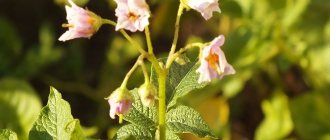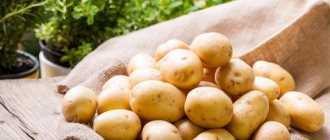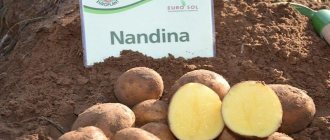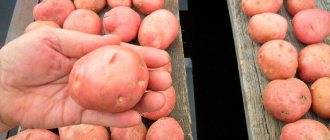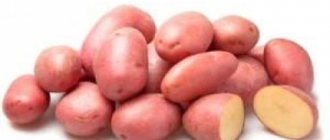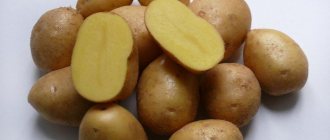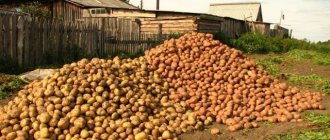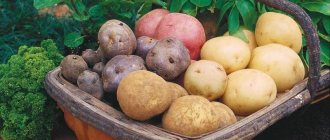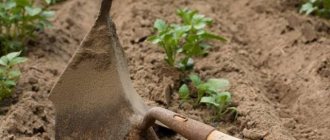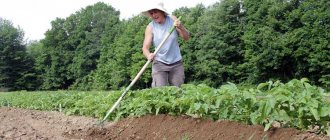Description of the variety
This potato variety appeared relatively recently and has not yet been included in the State Register of Breeding Achievements. The white swan is actively cultivated in Russia, Belarus and Ukraine.
Summer residents appreciate the variety for its heavy tuber weight and high yield - up to 10 kg per bush. It is not grown on a production scale in the Russian Federation.
The White Swan is characterized by:
- light large tubers with a pinkish tint of regular oval shape, weighing from 200-500 g;
- thin peel that is easy to peel off;
- high starch content;
- semi-spreading bushes of medium height;
- white color of the pulp.
The White Swan is mainly raised by private farmers and hobbyists. It ripens by September if you follow the watering regime and first take care of processing the tubers for planting.
Chemical composition, trace elements and vitamins
100 g of vegetable contains:
- 11.4% carbohydrates;
- 2.84% water;
- 2.13% protein.
This variety contains the most ascorbic acid, tuberin, B1, B2, B5, B6 , potassium, calcium, silicon, magnesium and other trace elements. Potatoes traditionally contain a lot of starch (up to 36.8%), fiber, and pectin.
The predominant mineral salts in tubers are potassium and phosphorus salts , and the organic acids are citric, oxalic, and malic. White Swan makes excellent dietary dishes such as puree or crumbly boiled tubers.
Ripening period, climate requirements and disease resistance
White Swan is considered an early ripening potato - 70-90 days . Already in early autumn, it is dug out of the ground and eaten.
The variety is demanding on soil , but during pre-planting treatment of tubers it demonstrates disease resistance. Rarely susceptible to potato blight and nematode, but susceptible to late blight.
Potatoes grow in light sandy soils with a neutral or slightly acidic pH . If the acidity levels exceed the pH range of 5.5–7.0, then it is better not to plant. The variety is suitable for cultivation in the Central Black Earth, North Caucasus, Middle Volga and other regions of Russia.
This is interesting:
Early ripening potato variety "Nandina" with good keeping quality
High-yielding potato variety with o
Time-tested oldest potato variety "Lorch"
Agrotechnics of cultivation
Due to the fact that White Swan planting material is imported without certification, special attention should be paid to preparing tubers for planting. All tubers that raise doubts about quality should be discarded.
Optimal planting dates
We should talk about the timing of planting potatoes in the context of a specific region. The general rule is this: the soil should warm up to +6...+9°C at a depth of 10–13 cm.
Under normal weather conditions, the earth warms up to this temperature in the southern regions already in late March - early April. In the middle zone and northern regions - a month later.
To find out if it's time to plant potatoes, you can use the following rules:
- Dig up 2/3 of a shovel's worth of soil at the planting site, remove a lump of soil from the bottom of the hole and throw it from the height of your arm bent at the elbow onto solid ground. If the lump has broken up, it’s time to plant; if it has crumbled into small pieces, it’s too late to plant. And if the lump has just squashed, it’s worth waiting a little longer.
- Based on the air temperature: daytime - not lower than +15°C, nighttime should not fall below +5°C.
Important! The best place to store potatoes is a cellar or basement pre-smoked with sulfur with a constant air temperature of +1...+2°C and an air humidity of 80–85%.
Features of crop rotation
Crop rotation is the most important agricultural technique, following the rules of which has a positive effect on crop yield indicators.
Potatoes grow well where they were previously grown:
- cabbage;
- legumes (except beans);
- pumpkin;
- strawberries;
- corn;
- green manure.
The crop germinates well and produces a harvest in the areas where it was grown before:
- greenery;
- onion and garlic;
- carrot.
You should not plant potatoes where the following vegetables previously grew:
- tomatoes;
- eggplant;
- pepper.
You should not replant vegetables in the same areas earlier than the fourth year.
Also find out what is best to plant after potatoes.
Soil conditions and composition
The best substrate for growing potatoes is well-fertilized black soil, with the addition of wood ash and superphosphate. In addition, White Swan also grows on light sandy soils, with a neutral or slightly acidic pH. If acidity levels exceed the pH range of 5.5–7.0, White Swan grows poorly on such soils.
The planting site should be well heated by the sun; it is advisable that the site is not in a lowland. If, in addition to such a place, there is also the presence of natural or man-made shelter from the wind (buildings, trees or tall shrubs), we can assume that you have found the ideal site for planting.
Preparation of planting material
3 weeks before you plan to plant, you need to take the tubers out into the air. Every day they are laid out in a place well lit by sunlight for 7–10 hours. In addition to solar heat and light, it is necessary to create conditions of sufficient humidity (ultraviolet light and moisture contribute to the awakening and rapid germination of tubers).
Large planting material is cut into fragments, each of which should have 2-3 eyes. When the shoots reach 4–6 cm in length, the tubers can be planted. Immediately before planting, the tubers are treated with fungicides (copper sulfate 1 tsp per 1 bucket of water), a solution of potassium permanganate (0.5 g per 1 bucket of water), minerals (ash) and growth stimulants (sodium humate, "Mikon", " Poteytin").
Landing technology
If the soil on the site is clayey (heavy), in the fall, when digging, you need to add sifted river sand and ash. In March, 2–3 weeks before planting, the soil is dug up again, 2 tbsp are added per square meter. l. ammonium nitrate or urea.
We recommend that you read
Features of applying fertilizers for potatoes during planting
It wouldn’t hurt to add peat (1 bucket/1 m²). If sandy soil predominates, in the fall add 1 bucket of peat, loam and humus per 1 m² of area.
Sand, clay, manure and compost should be added to the peat substrate (2/3 buckets per 1 m²).
In addition, you should add a cocktail of mineral fertilizers:
- superphosphate - 2 tbsp. l;
- potassium sulfate - 1 tbsp. l;
- ash - 1 cup.
The listed components are dissolved in 1 bucket of water (the volume of the solution is intended for 1 m² of area). The row method is used for planting potatoes. The distance between the rows is 80–90 cm, the depth of the holes is 12–15 cm. If the soil is heavy, the tubers are buried at a shorter distance—up to 10 cm.
When carrying out planting work, follow simple rules that contribute to a better harvest:
- potato rows should be divided along a north-south axis;
- for planting material, take only the best tubers, it is advisable that they were not grown as a result of crossing different varieties (pure breed);
- the normal weight of a planting tuber is 70–100 g;
- Place onion peels into the hole along with the tuber - parasites cannot stand them.
The main advantages and disadvantages of the variety
Among the advantages of the White Swan:
- excellent presentation - white color and smooth surface, which gave the name to the culture;
- early ripeness;
- high yield.
There are also disadvantages:
- potatoes have a neutral taste, which not everyone will like;
- medium crumbly, darkens when cooked;
- Doesn't last long.
Difference from other varieties
White Swan ripens faster than other varieties and is considered not particularly demanding on soil quality. Potatoes also differ in weight: if other varieties have tubers of 100-130 g, then White Swan is much larger - up to 500 g.
Features of care
The White Swan variety is very responsive to proper care and is demanding of soil and climatic conditions in the cultivation region.
For potatoes, the germination phase is an important period. To ensure that potato sprouts are not delayed in development and that the seedlings are as friendly as possible, it is recommended to harrow the soil. This allows not only to destroy weeds, but also to destroy the soil crust, which prevents the penetration of air to the root system and increases the rate of moisture evaporation.
Hilling begins after the seedlings have reached 10-15 cm in height. Hilling of plants is carried out at least three times, the last such procedure is important to perform before the potatoes bloom.
Excessive application of nitrogen-containing fertilizers can delay tuber formation and also enhance the growth of potato tops. Nesting application of manure or a solution of bird droppings under each potato bush is a more useful and economical way of feeding.
You may also be interested in the article in which we talk about Tiras potatoes.
Features of planting and growing
Plant potatoes when the ground warms up to +6...+9°С . Planting is carried out at a depth of 10-15 cm, the distance between the beds is 55-60 cm. On the day of planting, the tubers are cut lengthwise into three parts with eyes. Each fraction is planted separately. Renew the landing site every 2-3 years.
Preparing for landing
A month before planting, the tubers are laid out in the sun for half a day . This activates their growth. During germination, the optimal air temperature is at least +8...12°C.
Tubers are treated before planting with growth stimulants and insecto-fungicidal agents . Sometimes a solution of copper sulfate is also used. Treatment with nitrogen-phosphorus fertilizers will ensure the ripening of the crop a week earlier and 7-10% more than planned.
Soil requirements
It is best to plant potatoes in black soil, flavored with manure, wood ash and superphosphate, or in sandy, loamy soil. Do not sow in dark places. This will lead to the appearance of small tubers. The soil should be moderately moist. Peat areas are not suitable for sowing.
Features of cultivation
For a bountiful harvest, it is advisable to harrow the soil and destroy weeds . Seed tubers are planted at a temperature of at least +8…+10°C.
Hilling is carried out after the appearance of 10-centimeter shoots. This procedure is performed at least three times during the entire growing season. The soil is loosened after every heavy rain.
Potato growth is stimulated:
- slurry, pet urine, stale bird droppings;
- regular watering;
- ammonium sulfate, ammonium nitrate, superphosphate in the form of fertilizer;
- loosening and hilling the soil.
Attention! No earlier than a week before harvest, the tops are mowed, leaving a minimum for reference, so that all the useful substances go to the growth of the tubers, and the peel is denser.
Nuances of care
Potatoes do not require constant care . It is necessary to occasionally weed, hill up and feed the soil, as well as ensure a normal level of humidity.
A month after planting, the tubers are fed with urea, superphosphate, and ammonium sulfate. The procedure is repeated when the buds appear and after flowering.
Advice. During flowering, potatoes will not be harmed by good mulching with humus or rotted sawdust. This will protect the earth from severe summer overheating.
Watering mode
Potatoes need periodic mechanical or manual watering : 2-3 times a week during the budding and flowering stages. They begin when the shoots have reached 10 cm. Before buds and flowers appear, they water rarely - once every 7-10 days, but with plenty of warm water so that the ground is well saturated with moisture. Do this early in the morning or in the evening.
Top dressing
Potatoes are fed in a variety of ways. Dissolve in 10 liters of water :
- 1 tbsp. l. urea, 0.5 liters of mushy mullein or 1 tbsp. l. bird droppings;
- 1 tbsp. l. potassium sulfate, 2-3 tbsp. l. wood ash;
- 2 tbsp. l. superphosphate and 1 tbsp. mushy mullein (or chicken droppings).
Foliar feeding is carried out 2 times a month . A month before harvest, the crops are sprayed with an infusion of superphosphate, which promotes the ripening of potatoes.
Weeding and hilling
Regular weeding and hilling protect seedlings from weeds and accelerate the ripening of tubers. Loosening the soil prevents moisture loss and provides air access to the crops. Hilling is also directed against the Colorado potato beetle: insect eggs laid under a layer of soil die when dug up. An optimal air regime is created for the formation of a powerful root system and the growth of large tubers.
Features of caring for the variety after planting
The main advantage of the White Swan is its high productivity. However, to achieve high performance it is necessary to create appropriate conditions. This also applies to the use of agricultural techniques and the application of fertilizers. Among the agrotechnical techniques that contribute to obtaining a high potato yield, the need to pick off potato flowers during the flowering period should be highlighted.
Important! Do not overuse nitrogen fertilizers during tuber formation
—
the mineral suppresses their development, but enhances the growth of green mass (tops).
Fertilizer and irrigation
During the flowering period, the seedlings are fed with nitrogen fertilizers. During the formation of ovaries, they are sprayed with a solution of copper sulfate (0.05%) or boric acid. Bird droppings or manure are good as organic fertilizers. These substances have a strong effect on plants (they can burn), they should be used carefully.
You can properly prepare fertilizer based on them in this way:
- Take 100 liters of water and 4 kg of litter or manure, stir well, place in a warm place, out of direct sunlight.
- After some time (5–10 days), a characteristic smell will be felt, which will indicate the readiness of the product.
- Water the pre-moistened soil around the trunk with the prepared fertilizer (1 liter of fertilizer/1 bush).
After the formation of buds, the plants are fertilized with a mixture of ash and potassium sulfate. The components are mixed and sprinkled on the rows of bushes. For 1 m of potato rows, a mixture prepared from 1/3 cup of ash and 2 tbsp. l. potassium sulfate. As for watering, under normal climatic conditions, three additional waterings are sufficient throughout the entire growth period.
These irrigations are carried out at the following stages of the growing season:
- When the bushes grow to 8–11 cm, at this stage watering is needed for the growth of tops.
- Flowering - to produce more tubers.
- After flowering ends - so that the tubers are larger.
Did you know? Finding out whether the acidity of the soil in an area for growing potatoes is simple: if you notice clover, wheatgrass, dandelion and coltsfoot among the wild grass, the acidity is suitable.
If there is little rainfall in spring and summer, additional watering is necessary. On average, row spacing needs to be watered once every 7–10 days; the amount of water depends on how dry the weather is. The drip method is also used for watering potatoes. It is simple and effective.
Drip irrigation is carried out in this way:
- Take a hose of suitable length and make holes along its entire length (diameter - 2 mm). Install a plug at one end of the hose, the other will connect to the water source.
- Connect the free end of the hose to a source of moisture (faucet, reservoir, pump), and place the hose itself between the rows.
- As the soil becomes moist, move the hose from one row to another.
After watering, it is necessary to harrow between the rows to avoid the formation of a crust on the soil surface.
Weeding
Weeding and hilling are the most important procedures that promote potato growth and yield. In addition, these measures prevent the emergence and development of diseases and pests.
Check out
Why do you need hilling potatoes, and how to do it correctly? The first weeding is carried out 7–10 days after the appearance of the first shoots. During the growing season, bushes should be weeded at least four times. After weeding, weeds should be removed from the area outside the garden, where they are destroyed - do not forget that these are potential sources of disease.
After the bushes reach 12–15 cm in height, they should be hilled. The procedure is carried out at least 3 times (more is possible), the last hilling should be done before the bushes bloom. Hilling is the most important activity when growing potatoes.
The procedure is carried out for the purpose of:
- an increase in the number of side shoots, respectively, a larger number of tubers;
- better protection from wind and cold;
- removing crust from the soil surface;
- weed removal;
- to prevent potatoes from turning green;
- to facilitate subsequent harvesting and care of potatoes during growth.
You can cover potato bushes with mulch (peat, hay, sawdust). In this case, hilling is not carried out, and the mulch is removed immediately before harvesting.
Disease and pest control
The extent to which the variety is able to resist diseases and pests is a controversial issue; gardeners have differing opinions on this matter. In this regard, when growing it, one should proceed from the consideration that it is better to protect the plantings from most known diseases and pests.
The most common crop diseases:
- scab;
- golden nematode.
Did you know? The nematode does not tolerate growing the following crops next to potatoes: rye, marigolds, calendula, legumes, mustard, clover. If you sow rye in the first half of September, 9 out of 10 pest larvae die in this place.
By following the rules below, you can significantly reduce the risk of these diseases:
- for planting, use only whole, undamaged tubers of the same variety;
- disinfect garden tools;
- follow the rules of crop rotation;
- do not use greenhouse soil in open-air beds;
- carefully and deeply dig up the soil in the fall, removing remnants of weeds from outside the garden;
- before planting potatoes, the tubers need to be treated with fungicides (copper sulfate solution, Albit), and the soil with urea (2 tbsp/3 m²);
- fertilizing with potassium, ash, and superphosphate increases nematode resistance;
- treat the tubers before planting with a solution of potassium permanganate (0.5 g/10 l of water);
- if cabbage was grown on the site before potatoes, you should carefully inspect the area for the presence of larvae, which often remain after this vegetable.
To treat potatoes against possible diseases, fungicides and copper-based products (vitriol) are used:
- "Nemabakt", according to the instructions.
- "BI-58" or 0.02% mercaptophos solution. Bushes affected by the disease are sprayed once a week.
By following the laws of crop rotation, the threat of scab development is minimized. Timely feeding with minerals is very useful for prevention. But organic matter should not be overused, especially with incompletely rotted manure. If, nevertheless, the bushes and tubers are affected by scab, Fungazil and Aquaflo are used for treatment, according to the instructions.
Read more about how to deal with potato diseases.
Harvest and storage
Harvest in August - September . The ripening of tubers is indicated by yellowing of the tops. To check whether the potatoes are ripe, dig up one bush from the garden bed. After harvesting, collect any remaining tops and weeds.
How and when to collect
Harvest times vary in each region , but the average time for tubers to ripen is 70-80 days after sowing. The bushes are dug up from the side and pulled out by the remains of the tops. After this, the tubers are collected and placed in a bucket or cart.
Storage features and keeping quality of the variety
After harvesting, the potatoes are sorted to avoid rotten vegetables getting into storage. For better storage, the crop is treated with copper sulfate.
So that the tubers last a long time:
- they are placed in a dry, cool, dark place;
- maintain temperature regime +2…4°C;
- provide air access to the room.
In order for tubers to be stored longer, they must be fully ripe, without green bloom or damage.
For your information. Potatoes spoil less if you store them in a box together with plant leaves (for example, fern, rowan, elderberry).
White Swan does not belong to the keeping varieties of potatoes . Like all early varieties, it is stored only until winter. Tubers with hard skins and no signs of rotting are best stored.
The seed material of this potato variety is not certified . When there is heavy rain, the tubers begin to sprout while still in the ground, which affects the keeping quality.
Features and Benefits
Potatoes of the White Swan variety are capable of forming bushes of medium thickness and average foliage. Potato tubers are quite large. With proper care, the average weight of a vegetable can reach 500 g or more. Potato skins are thin. The vegetable is white in color, with purple and pinkish eyes. When cut, the flesh of the tuber has a milky white tint. The starch content in the vegetable is moderate.
This potato variety is characterized by its high yield.
At the end of the season, each potato nest consists of 18-30 large tubers. There are no fine and seed fractions.
Landing rules
It is worth noting that the white swan potato variety has several advantages and disadvantages. And we will talk about each such point in more detail. But first, we’ll tell you the rules for planting this vegetable.
Excellent predecessors for this variety of potatoes are cabbage, corn, all kinds of root vegetables, cucumbers, and strawberries. Beans are not one of them!
- The area of a garden plot does not always allow for the correct alternation of vegetable plants. For this reason, it is best to start preparing the soil for planting with the onset of autumn.
- The most suitable soil for White Swan potatoes is black soil. Before planting a vegetable, you should definitely add fertilizer to the soil - manure, superphosphate or ash.
- In the prepared area, it is necessary to prepare even rows with a distance of 55-60 cm from each other. Planting holes should be dug in these rows. Their depth should be no more than 11-15cm.
- Basically, all seed material of the White Swan potato variety is not certified. For this reason, proper pre-planting treatment of tubers will require special attention.
- It is imperative to check the planting material and select low-quality tubers. Before planting, tubers should be treated with special growth stimulants and various insecto-fungicidal agents.
- In addition, you can pre-treat the tubers with a weak solution of copper sulfate (2 grams of the product per 10 liters of water).
What difficulties may there be when growing
The white swan becomes a victim of insect attacks or viral infections . To prevent this from happening, carefully care for the beds and prevent diseases and other signs of damage in a timely manner.
If a potato becomes infected with a virus, the tops will wither and fall off prematurely, and the tubers will begin to rot. If attacked by pests, the vegetable will become unfit for consumption.
Advice from experienced gardeners and reviews about the White Swan variety
Experienced gardeners advise :
- Regularly treat bushes with fungicidal preparations. This will avoid infection with fungi and darkening of the tubers inside. Such potatoes are unsuitable for storage and sale.
- Do not get carried away with nitrogen fertilizers. This will increase the wateriness of the potatoes.
- Do not store the harvested crop together with other vegetables and fruits. This increases the risk of contamination and product spoilage. It is permissible to have potatoes next to beets only.
- A couple of apples in boxes with potatoes will help prevent germination.
Reviews about the White Swan are not always positive . The reason is the low taste qualities - watery, tasteless tubers. Many people don’t like the fact that potatoes darken when cooked. However, for sale this variety is considered one of the best, as it is large, beautiful to look at and grows quickly.
Vladimir Gordienko, Krasnodar : “Last year we planted for the first time. We are quite happy, since we got two large buckets from one bush. But many of the tubers were sprouted. This, of course, is a minus - you can’t put these in the basement, you need to eat them right away. Otherwise we are satisfied. The potatoes are clean, smooth, and have a pleasant color.”
Svetlana Kirova, Saratov : “I’ve been planting a white swan for sale for three years now. Unpretentious variety. I'm happy with everything. Buyers quickly take apart such beautiful and clean potatoes, since they actually do not need to be peeled. You can cook it and eat it like that.”
Pavel Toptunov, Bakhchisarai : “Excellent variety - I recommend it to everyone. When digging, dirt does not stick to it, which means there is no need to clear lumps of earth. Swan grows quickly and produces a harvest that no other variety has produced in our country so far.”
Potato variety White Swan: characteristics of a high-yield crop
White Swan potatoes have recently begun to be grown in Russia. This variety has not yet even been included in the official Russian register. But thanks to their delicious taste, potatoes have already gained popularity among ordinary gardeners.
Potato White Swan - what kind of variety is it?
Potatoes of this variety respond very well to proper care. It is also not demanding on soil and climate. At the same time, the crop is famous for its high yield. All seeds are imported and have not been certified. Therefore, this potato is not grown on an industrial scale. Mostly private farmers and amateur gardeners plant them on their plots.
Ripening time and yield
This type of potato belongs to the mid-early varieties, harvesting occurs in August. The ripening period is 80-90 days. The variety is characterized by high productivity. From one bush you can harvest 10 kilograms of crop.
Potato variety White Swan
Additional Information! The variety differs from its relatives in its high yield. One potato nest consists of 25 large root vegetables.
Disease resistance
The white swan has strong immunity. The bushes are resistant to the following diseases:
- late blight;
- rhizoctonia;
- black mold;
- rust.
They have average resistance to scab and black spot, but are weak to virus Y. They do not tolerate drought well; on hot and dry days the plant needs abundant watering.
Characteristics of tubers, description of appearance
White Swan potato bushes are erect and spreading, up to 60 centimeters high. The leaves are dark green with a wrinkled structure. The flowers are white - bluish in color.
The tubers are massive, light, with a pink tint. The eyes are shallow, pink or purple. The weight of one potato is between 200-500 grams. The pulp is light, when cut, it resembles semolina porridge.
For which regions is it suitable, climate requirements?
Potatoes are suitable for growing in the Central Black Earth, North Caucasus, Middle Volga and other regions of Russia. It is very popular in the Vitebsk region. The variety is widespread in Ukraine and Belarus.
Taste qualities
Potatoes contain a large amount of tuberin, as well as vitamins B1, B2, B5, C. 100 grams of potatoes contain:
- 11.4% carbohydrates;
- 2.84% water;
- 2.13% protein.
The tuber contains about 36 percent starch - this variety will fall apart when cooked. White swan is good for making puree. The taste of potatoes is neutral.
Note! The higher the starch content in the potatoes, the fluffier the mashed potatoes will be.
The main advantages and disadvantages of the variety
The White Swan variety has both strengths and weaknesses. The advantages include:
- high productivity;
- early ripening of tubers;
- rapid development of tubers;
- ease of care;
- has high resistance to diseases.
Among the weaknesses are the following:
- low resistance to virus Y;
- darkens during cooking and becomes soft;
- does not tolerate drought and prolonged lack of rain;
- does not last long.
Planting and growing White Swan potatoes
Proper planting includes several stages, the main thing being the choice of location and preparation of the site.
The choice of location depends on:
- Illumination. Potato beds should be illuminated at least twelve hours a day.
- Ventilation. The area on the north side should be fenced to protect it from the cold wind.
- Predecessors. You can plant potatoes in an area where cucumbers, beets, and cabbage used to grow.
Note! It is not recommended to plant root vegetables in the same place where tomatoes or eggplants were planted.
Preparing for landing
Before planting, the tubers need to be germinated. Only healthy root crops are selected for planting. If they have long and thin shoots, they must be removed.
Containers with potatoes need to be exposed to the sun to germinate new sprouts. For greater efficiency, tubers can be treated with growth stimulants Epin/Zircon or other means. The crop is planted in early May; before this time the soil has time to warm up.
It is necessary to prepare the soil for planting in the fall. The area is dug up and organic matter is added. In this case, the shovel should go into the soil up to the bayonet. At the same time, weeds are also removed.
In the fall, you can plant green fertilizers (green manure):
Plants rot and turn into organic fertilizers, and when planted densely, they prevent the growth of weeds.
Green manure enriches the soil and increases productivity
In the spring, it is necessary to lightly loosen the area. If there are earthen breasts, they need to be broken up using a rake or fork.
Additional Information! In spring, nitrogen mixtures are added to the soil and treated with herbicides.
Soil requirements
Nutritious and loose soil is suitable for planting. The acidity should be no less than 5 and no more than 7 pH. Too acidic soil can be diluted with limestone.
Dates, scheme and rules of planting
Planting times depend on the region:
- northern regions - 2, 3 days of May;
- temperate latitudes - first week of May;
- southern regions - second week of April.
After choosing a location, you need to prepare the holes. The recommended depth is 7 cm, according to the pattern 35x80 cm. For better growth, pour a thin layer of wood ash into the hole. Then the tubers are placed there, the distance between them is 75-80 centimeters. After the hole they are covered with earth. When the first shoots appear, they are earthed up.
How to properly care for the variety
The main advantage of the White Swan potato is its high yield. To achieve maximum results, it is necessary to create appropriate growing conditions. Caring for potato bushes includes:
- watering;
- feeding and fertilizing;
- hilling;
- weeding.
Before the first shoots appear, about 5 days in advance, it is necessary to clear the area of lumps and breasts.
For reference: some gardeners rate the taste of the White Swan potato so highly that they call it gold.
Features of watering
At the early stage of the growing season, the plant needs watering every three days. When the bushes grow to 15 centimeters, watering can be reduced to once every ten days.
Source: https://OgorodGuru.com/ovoshhi/kartofel-sort-belaya-lebed
